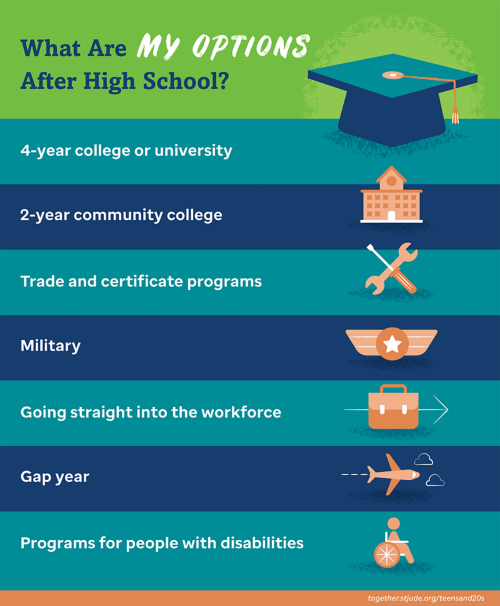What happens next: many options for after high school
May 19, 2022
With the end of high school getting closer and closer and finals almost upon us, we look forward to what’s going to happen next. The majority of us will be attending four year colleges with some people attending community colleges, but did you know that there are more options than that? I’m going to be taking a look at a lot of these potential options and I will be listing some positives and negatives of each.
Four year college
A four year college is traditionally an undergraduate degree program that leads to a bachelor’s degree in a specific area of study. Student’s usually complete a bachelor’s degree to prepare for a profession after college, enter a graduate program, or even both. This is a choice that a majority of students will be making. We had to fill out college apps, submit our test scores, transcript and write essays by a deadline. The positives of a four year college is that there are a wide range of majors that you can choose from, you’ll get a traditional college experience and you’ll be educated in a wide range of subjects through general education requirements. Some of the negatives are that tuition can be expensive, and universities tend to have larger class sizes with more students in each class than what you’re used to.
Two year or community college
Community colleges offer a degree program called an associate’s degree. This degree either prepares you for a career after graduation or to transfer to a bachelor’s degree program. You can usually transfer from a two year college to a four year university to earn a bachelor’s degree. The positives of community colleges is that they’re more cost effective, and they’re good if you don’t know what you want to major in. Some of the negatives are that it’s a different atmosphere from four year colleges, it’s harder to transfer credits and there’s fewer degree options.
Trade School
A trade school trains students in technical skills to prepare for certain jobs. When you graduate from a trade school, you receive a diploma or certificate confirming that you completed the program. Examples of occupations include electrician, plumber, chef, mechanic and computer technician. The positives about trade schools are that some of the most in-demand jobs are in the trades, there’s a variety in programs and it’s good for preparing you to have a career. Some negatives include limited career growth, financial aid and flexibility.
Military
The military has five branches: Navy, Army, Air Force, Marine Corps and Coast Guard. Each of these branches has its own focus and career options. To apply for the military, you have to take the Armed Services Vocational Aptitude Battery test, which measures developed abilities, and it helps predict future academic and occupational success. Each branch also requires you to pass a physical examination and meet certain weight requirements. Some positives of joining the military is that it provides a salary, benefits, job training and travel. The negative is that the military requires you to commit to a certain number of years of service.
Going straight into the workforce
There are several jobs available for high school graduates that pay good salaries. Many of these jobs do require an apprenticeship, which is a period when a new worker is paid while training under someone with more experience and skill. The positives of going right into the workforce is that you gain valuable experience and you get paid while doing it. Some negatives are that you’re missing out on opportunities, there’s less time to focus on school and there’s less time to do any activities outside of work.
Gap year
This is a period of time that people use to explore areas of interest and earn money before starting a college or career. People who take a gap year often work, volunteer, travel or a combination of these things. The positives of a gap year are that you have time to think about what you want to do and you can take a break to recharge. The negatives are that the transition back to school may be difficult, you can feel like you’re behind your peers and it requires a lot of planning.
Study abroad
This is an opportunity to pursue an educational program in a foreign country while earning credit towards a degree. Some people study abroad to gain new language skills and to broaden their views of the world. The positives of studying abroad include making new friends from around the world, gaining a global perspective and you can experience new places and cultures. The negatives include language barriers, being on your own and expenses.
With all of these options it can be hard to choose the best one for you. You can try any of these things out and change your mind if you realize that it isn’t for you. With all of this said, I wish the class of 2022 the best of luck in whatever future plans they decide to partake in.


